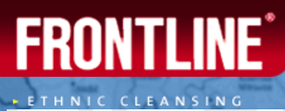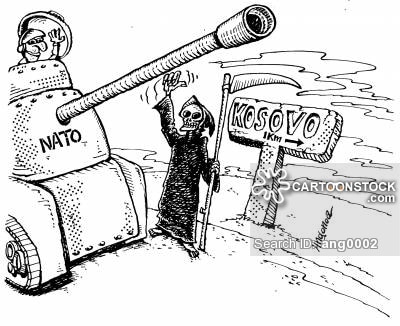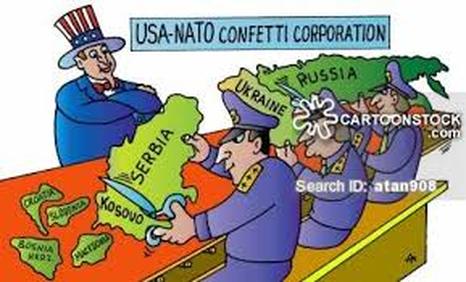1. How did Kosovo slide into war 1996-1998?
Starter:
1. Making Hypothesis:
- Make a list of the different stakeholders or (to use the appropriate political sciences term) 'actors' in and around Kosovo by 1996.
- Discuss, as a group, their various aims.
- Now consider their current trajectories - i.e. by 1996 in which direction are they heading? (e.g. becoming more/less powerful, their views becoming more/less extreme etc)
- Form an overall hypothesis - what would you expect to happen next and why?
Main Activity:
2. Click: Interpreting Cartoons (for discussion/group consideration)
3. Directed Reading (working independently, use the 'Slide into War' frame below to help you to make notes from the textbook pages 177-182)
4. Review the cartoons on pages 181-182. In a small group, take one of the questions on page 182, discuss and then present briefly to the class.
1. Making Hypothesis:
- Make a list of the different stakeholders or (to use the appropriate political sciences term) 'actors' in and around Kosovo by 1996.
- Discuss, as a group, their various aims.
- Now consider their current trajectories - i.e. by 1996 in which direction are they heading? (e.g. becoming more/less powerful, their views becoming more/less extreme etc)
- Form an overall hypothesis - what would you expect to happen next and why?
Main Activity:
2. Click: Interpreting Cartoons (for discussion/group consideration)
3. Directed Reading (working independently, use the 'Slide into War' frame below to help you to make notes from the textbook pages 177-182)
4. Review the cartoons on pages 181-182. In a small group, take one of the questions on page 182, discuss and then present briefly to the class.
|
| ||||||||||||
2. What were the key features of the Racak Massacre and other ethnic cleansing incidents?
|
We are going to go straight into watching a BBC documentary from 2001 called 'The Fall of Milosevic, Episode 1: Defiance' which we shall call Source A.
Starter: With reference to Origin and Purpose, discuss the values and limitations of Source A to a historian studying the responsibility for the escalation of violence between 1996-1998 in Kosovo? Discuss and record on the board. 1. Watch the documentary from 30:25 to 1:00. As you watch: a) Review your notes from last lesson - this portion of the video will expand on all of the aspects - add any extra notes. b) Insert a grid under your table from last lesson - 'Who was to blame for the escalation in violence?' with three columns ('The Sebs', 'The KLA', 'Other Actors') Your teacher will pause it every so often to help you complete. 2. At 1:00 to 1:06.10 the video goes into the Racak Massacre - this is a key event in this history. Add a subtitle 'The Racak Massacre January 1999' underneath and summarise the key features of the event as bullet points. Note the ambiguity in what happened. *There is graphic footage of the outcome of the massacre here and so you may wish to listen to the audio only from 1:03. 3. Review: Thinking back to your answer to the OPVL question at the start of this lesson. With reference to the content that you have seen, is there any evidence of the values and limitations you identified? Home Learning: Complete the Debate Assignment on page 186, using the sources on page 187-88 or complete the examination style questions on page 188. |
|
3. Why did NATO begin 'Operation Allied Force' in March 1999? The Failure of the Rambouillet peace talks
Starter
Read to class: in 1999 there was a joke going round Belgrade. The Punchline was "No Action, Talk Only" - what was preceding question?
On 24th March 1999, the NATO began their bombing campaign against the Federal Republic of Yugoslavia (FRY) known as 'Operation Allied Force' that would continue for 77 days. As we have seen from our study of Rwanda, the international community was slow to consider military intervention in the 1990s and Kosovo should not have been an exception.
1. As a class, think of the following nations - what are their attitudes likely to what would essentially be a declaration of war on Serbia over an issue that could arguably be considered a domestic policing matter for the FRY:
US, Russia, Great Britain, France (consider: the experience of Rwanda, what we learnt about some of these countries and Rwanda, geo-political changes and fears of the period as the USSR collapses, the nature of decision making in the UN)
2. Download the document below and use it in conjunction with the video (from 1:06 to the end) and then the textbook pages.
|
| ||||||||||||
Home learning:
Complete the questions on page 194 of your textbook.
Complete the questions on page 194 of your textbook.
4. What were the key features of Operation Allied Force? (2 x lessons and hwk)
Note frame:
| operation_allied_force.docx | |
| File Size: | 19 kb |
| File Type: | docx |
LOOK REALLY CAREFULLY AT THE LAYOUT OF THE FRAME. YOU ARE GOING TO USE A RANGE OF SOURCES OVER A COUPLE OF LESSONS AND THE TEXTBOOK TO COMPLETE IT. FOLLOW THE SEQUENCE OF LEARNING BELOW OVER TWO LESSONS (WITHIN EACH PART, COMPLETE THE RELEVANT KEY EVENTS SECTION FIRST, THEN CHECK WHAT YOU CAN ADD INTO THE ANALYSIS BOXES).
1. THE START OF THE CAMPAIGN RESOURCES
1. THE START OF THE CAMPAIGN RESOURCES
Watch the first 23:00 only: Textbook:
Use sound only from 14 minutes to 17 minutes as the images are graphic
|
|
| ||||||
2. THE ETHNIC CLEANSING AND REFUGEE CRISIS - OPERATION HORSESHOE
|
1. Watch the Fall of Milosevic 33:37 - 37.06
Open file for pages 209-213 in your textbook. |
| ||||||
3. KEY EVENTS: - THE ACCIDENTS (REFUGEE CONVOY AND THE CHINESE EMBASSY) - NATO'S 50TH ANNIVERSARY - REASONS FOR END)
|
1. Watch the Fall of Milosevic 37:06 - 50:00 (accidents and escalation)
*note there are some graphic scenes in the 38th minute that you may wish to watch without the image 2. Watch the Fall of Milosevic 54:30 - 1:06.17 (getting agreement with Russia) 3. Watch the Fall of Milosevic 1:11.12 -1:16.28 (rebellion, indictment of Milosevic, the end) Open file for pages 202-208 in your textbook and pages 216-217 |
| ||||||
ADDITIONAL SOURCES:
Listen to the daily NATO press conferences on the (now old) CNN website: http://edition.cnn.com/WORLD/europe/9904/01/nato.attack.03/nato.maps/days.1.18/
BBC News 24 - Kosovo Refugee Crisis - US Soldiers on Trial - Nato bombs Belgrade (1999):
https://www.youtube.com/watch?v=BGcozvcoH4k
Listen to the daily NATO press conferences on the (now old) CNN website: http://edition.cnn.com/WORLD/europe/9904/01/nato.attack.03/nato.maps/days.1.18/
BBC News 24 - Kosovo Refugee Crisis - US Soldiers on Trial - Nato bombs Belgrade (1999):
https://www.youtube.com/watch?v=BGcozvcoH4k
5. What was the immediate impact of the NATO bombing campaign in June 1999? KFOR and the Pristina Airport Incident
1. You have 10 minutes to watch the two videos below individually. Create a new document with the above title and bullet point all of the immediate impacts that you can infer about the impact of the bombing campaign. Discuss with a partner - can we categorise these notes by stakeholder?
If you cannot get these videos to play try these 2 links:
"Russians block access to Pristina Airport"
https://www.youtube.com/watch?v=tdN5fIZA1lw
"Remembering Russian Paratroopers who foiled NATO plans to invade Serbia 20 years ago"
https://www.youtube.com/watch?v=VzZm2zdZ9_U
(the clips for these 2 are in the S Drive too).
If you cannot get these videos to play try these 2 links:
"Russians block access to Pristina Airport"
https://www.youtube.com/watch?v=tdN5fIZA1lw
"Remembering Russian Paratroopers who foiled NATO plans to invade Serbia 20 years ago"
https://www.youtube.com/watch?v=VzZm2zdZ9_U
(the clips for these 2 are in the S Drive too).
|
|
|
2. Read the pages below as a pair or on your own and build your notes from above (easy split is KFOR and Pristina)
| impacts_219_to_225.pdf | |
| File Size: | 3904 kb |
| File Type: | |
3. Additional / homework: Complete all questions on page 225 by hand
Watch this clip about James Blunt and Pristina: What can you say about the history presented and the perspective of the presenter (look up RT):
https://www.youtube.com/watch?v=yiR_gpEk4gw
Watch this clip about James Blunt and Pristina: What can you say about the history presented and the perspective of the presenter (look up RT):
https://www.youtube.com/watch?v=yiR_gpEk4gw
| pristina_airport_incident_and_james_blunt.docx | |
| File Size: | 213 kb |
| File Type: | docx |
Play the Kahoot at this link:
https://play.kahoot.it/#/?quizId=cca3da1d-e3dd-4ea0-b159-3ce5213871a9
User name and passwrod are the same as for wistorian. Code is 4672220
https://play.kahoot.it/#/?quizId=cca3da1d-e3dd-4ea0-b159-3ce5213871a9
User name and passwrod are the same as for wistorian. Code is 4672220


